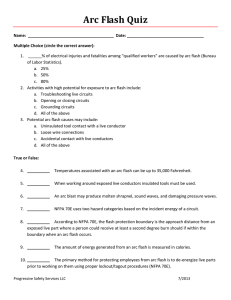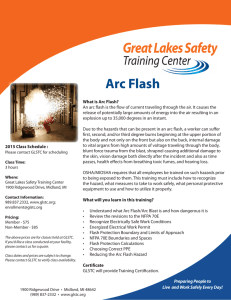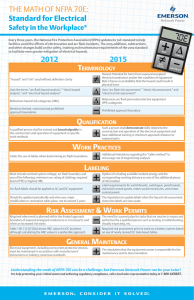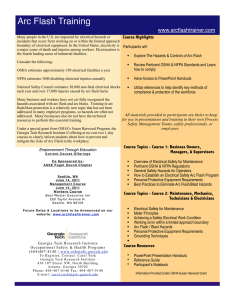NFPA 70e/OSHA - Technical Diagnostic Services
advertisement
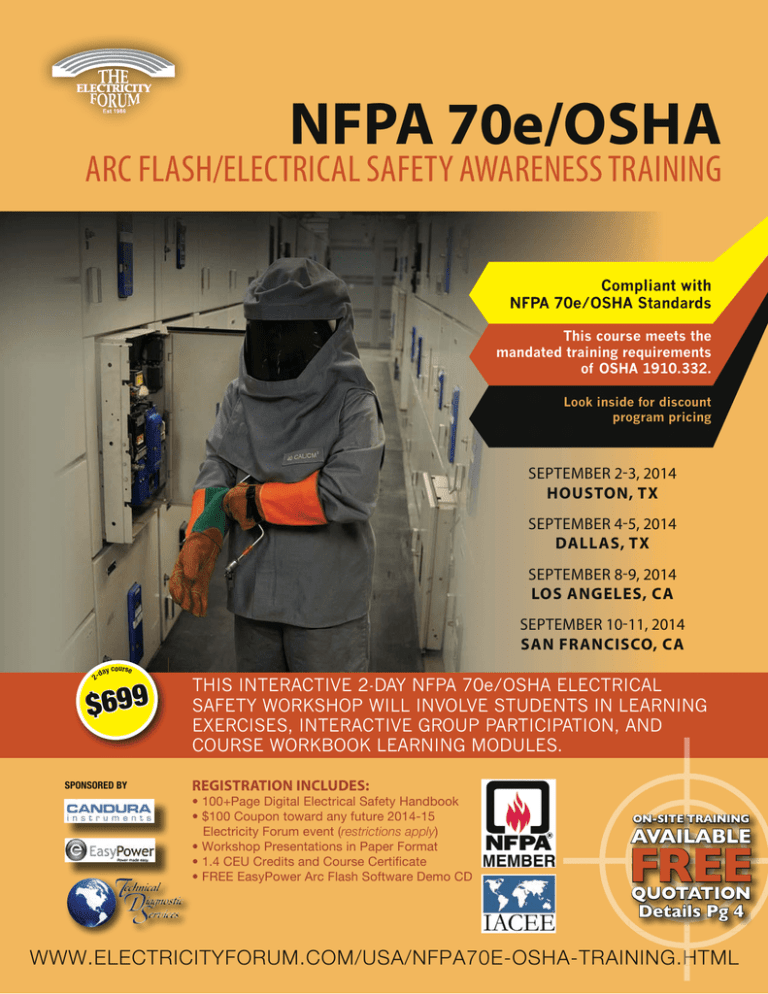
NFPA 70e/OSHA ARC FLASH/ELECTRICAL SAFETY AWARENESS TRAINING Compliant with NFPA 70e/OSHA Standards This course meets the mandated training requirements of OSHA 1910.332. Look inside for discount program pricing SEPTEMBER 2-3, 2014 HOUSTON, TX SEPTEMBER 4-5, 2014 DALLAS, TX SEPTEMBER 8-9, 2014 LOS ANGELES, CA SEPTEMBER 10-11, 2014 SAN FRANCISCO, CA 2- day course $699 SPONSORED BY THIS INTERACTIVE 2-DAY NFPA 70e/OSHA ELECTRICAL SAFETY WORKSHOP WILL INVOLVE STUDENTS IN LEARNING EXERCISES, INTERACTIVE GROUP PARTICIPATION, AND COURSE WORKBOOK LEARNING MODULES. REGISTRATION INCLUDES: • 100+Page Digital Electrical Safety Handbook • $100 Coupon toward any future 2014-15 Electricity Forum event (restrictions apply) • Workshop Presentations in Paper Format • 1.4 CEU Credits and Course Certificate • FREE EasyPower Arc Flash Software Demo CD ON-SITE TRAINING AVAILABLE FREE QUOTATION Details Pg 4 WWW.ELECTRICITYFORUM.COM/USA/NFPA70E-OSHA-TRAINING.HTML H ALL NEW INTERACTIVE ARC FLASH & ELECTRICAL SAFETY WORKSHOP PROGRAM DETAILS: WWW.ELECTRICITYFORUM.COM/USA/NFPA70E-OSHA-TRAINING.HTML THIS COURSE WILL TEACH YOU HOW TO: • Interpret and use the NFPA 70e standard • Establish an electrically safe work condition (lockout/tagout) • Explain contractor and employer (host) compliance responsibilities • Identify electrical safety training requirements for qualified workers • Identify best practice regulations that address shock and arc flash hazards • List the steps to perform a shock hazard analysis and describe each step • Define the three NFPA 70e shock protection boundaries and describe their use • List the personal protective equipment required for shock protection • List the steps to achieve an electrically safe work condition • List the steps to install and remove temporary protective grounding equipment • Explain what an arc flash is and the injuries that can result • Identify when an arc flash hazard exists • List the steps to perform an arc flash hazard analysis and describe each step • Define the term “incident energy”, identify the key electrical system variables that affect it • Define the term “arc flash protection boundary” and explain its application • Define the term “arc rated” and explain the difference between “flame-resistant” clothing and “arc rated” clothing • Select appropriate personal protective equipment for arc flash hazards • Describe the Hazard/Risk Category method of selecting arc flash PPE • List the testing and maintenance requirements for personal protective equipment • Identify the key objectives of job safety planning DAY ONE: NFPA-70e ARC FLASH/ELECTRICAL SAFETY WORKSHOP UNDERSTANDING ELECTRIC POWER SYSTEMS • Basic Electrical Theory and Definitions • Electrical Drawings • Ground Fault Systems • Time-Current Curves & Power System Studies • Electrical Arc Characteristics OVERVIEW • Electrical Hazards • Existing and Proposed Standards • Preparing to Work Safely • Determining Safe Approach Distance • Determining Arc Hazard Category • Fault Current Calculations • Determination of Arcing Fault Clearing Time • Boundary Calculations • Determining Arc Flash Hazard Risk Category • Incident Energy Exposure Calculations • Hazard Analysis INCIDENT CAUSES • Unsafe Switching Acts • Not following Operating Procedure • Unsafe Working Conditions • Not Following Maintenance Procedures ELECTRICAL HAZARDS • 5 Main Factors in Electrical Accidents • Electrical Shock • Arc Flash Defined • Incident Energy Defined • Arc Flash Burn Injuries • Arc Blast Pressure • Inhalation Injuries NG AND PROPOSED STANDARDS • OSHA 1910.269 • NFPA 70e-2012 Edition • NESC Rule 410A3 DEFINITIONS • Essential to the Application of This Standard PREPARING TO WORK SAFELY • Safety Training • Emergency Procedures • Detailed Description of a “Job Briefing” • Use of Equipment • Establishing an Electrically Safe Work Condition • Lockout/Tagout • Isolation and Grounding HAZARDOUS ENERGY CONTROL PROCEDURES • Individual Qualified Employee Control Procedure • Simple Lockout/Tagout Procedure • Complex Lockout/Tagout Procedure • Coordination • Training and Retraining EQUIPMENT • Lock Application • Lockout Tagout Device • Lockout Device • Tagout Device • Electrical Circuit Interlocks • Control Devices • Procedures • Planning SHOCK HAZARD PROTECTION (LIVE WORK) • Understanding and Applying NFPA 70e Tables • Shock Protection Boundaries • Limits of Approach • Energized Work Permit • Limited Approach Boundary • Restricted Approach Boundary • Prohibited Approach Boundary DETERMINING ARC HAZARD RISK CATEGORY (LIVE WORK) • Using NFPA 70e Table Method BOUNDARY CALCULATIONS • Detailed Examples and Exercises DETERMINING ARC FLASH HAZARD RISK CATEGORY • Detailed Examples and Exercises • Simplified Table Approach • Matrix Table Approach • Single Line Diagram • Short Circuit Study • Coordination Study • NFPA 70e Table – Protective Clothing and PPE Matrix INCIDENT ENERGY EXPOSURE CALCULATIONS • Selecting the Correct Level of PPE • NFPA 70e Calculation Method • Calculating Arc in a Cubic Box • Comparison of “Arc in Open Air” to “Arc in a Box” • IEEE 1584 Method ELECTRICAL HAZARD LABELS, ARC FLASH AND SHOCK LABELS • General • National Electrical Code Shock and Arc Flash Warning Label • Arc Flash Label Example • Detailed Arc Flash Hazard Analysis Label NFPA 70e AND PPE • Head, Face, Neck, Chin • Eyes • Body • Hand and Arm The Electricity Forum is a trusted leader in Electrical Safety training. More than 10,000 Electrical Professionals have turned to our company for unbiased, objective, commercial-free Electrical Safety training. Our motivation is your education! • Foot and Leg • Tools and measuring instruments PPE CLOTHING REQUIREMENTS, FR CLOTHING TESTING STANDARDS • The Evolution of Flame Resistant (FR) Fabrics • The Various Types of FR Fabrics that are Available in the Marketplace • FR Fabrics and the Effects of Undergarments • Review the Technology and Effectiveness of Inherently Flame Resistant Fibers vs. Chemically Treated Fabrics • Developing a PPE Program in Your Company • Assessing the Correct Arc Flash Hazard and Choosing the Right Level of Protective Clothing • Company Training and Worker Compliance • A Quiz to Ensure Student Understanding of the Day’s Information ARC FLASH SOLUTIONS • Arc Flash Study Analysis and Implementation • Power System Upgrades • Arc Resistant Switchgear • Circuit Breaker Retrofitting • Remote Breaker Racking • Regular Maintenance and Testing DAY TWO: OSHA ELECTRICAL SAFETY WORKSHOP OSHA Electrical Safety training is designed for industrial, commercial and institutional electricians, technicians, and engineers. They must be properly trained in all aspects of safety, maintenance, and operating procedures in order to do their jobs properly on complex electrical equipment and systems today. OSHA Electrical Safety regulations require all employers to document that their employees have demonstrated proficiency in electrical tasks before they can certify that they have been adequately trained. Also, employers must maintain this certification for the duration of the employees’ employment. Some OSHA electrical training regulations go even further by making it the employer’s responsibility to limit certain job assignments to employees who are “certified”, “competent”, or “qualified”, meaning that they have been specially trained to perform specific or specialized tasks. These requirements reflect OSHA’s belief that training is an essential part of every employer’s health and safety program. This OSHA Electrical Safety training course is designed to meet the minimum mandated requirements specified in OSHA 29CFR 1910.331 to 335 for those employees classified as “qualified” who work on or near exposed electrical parts operating at 50 volts or more, or for those employees classified as “unqualified” but who are exposed to electrical hazards during their job duties. This also includes those who supervise both qualified and unqualified personnel who are exposed to electrical parts operating at 50V or more. Scope - OSHA Standard 1910.331 • Section 1910.331(a) - Covered Work by Both Qualified and Unqualified Persons • Section 1910.331(b) - Other Covered Work by Unqualified Persons • Section 1910.331(c) - Excluded Work by Qualified Persons Training - OSHA Standard 1910.332 • Section 1910.332(a) - Scope • Section 1910.332(b) - Content of Training • Section 1910.332(c) - Type of Training Selection and Use of Work Practices - OSHA Standard 1910.333 • Section 1910.333(a) - General • Section 1910.333(b) - Working on or Near Exposed De-energized Parts • Section 1910.333(c) - Working on or Near Exposed Energized Parts Use of Equipment - OSHA Standard 1910.334 • Section 1910.334(a) - Portable Electric Equipment • Section 1910.334(b) - Electric Power and Lighting Circuits • Section 1910.334(c) - Test Instruments and Equipment • Section 1910.334(d) - Occasional Use of Flammable or Ignitable Materials Safeguards for Personnel Protection - OSHA Standard 1910.335 • Section 1910.335(a) - Use of Protective Equipment • Section 1910.335(b) - Alerting Techniques • Personal Protective Equipment • Protective Techniques • Electrical Protective Equipment • Arc Protective Equipment • Blast Protective Equipment • Other Protective Equipment • Energy Detection Equipment OSHA 29 CFR 1910.302-303 • Subpart ‘S’ Safeguarding of Employees • 302 - Electric Utilization Systems • 303 - General Requirements • Working Space About Electrical Equipment • Restrictions on Personnel Access to Electrical Equipment • Use of Portable Equipment OSHA 1910.269 - Electric Power Generation, Transmission, and Distribution • Electric Power Generation, Transmission and Distribution • Operation and Maintenance of Generation and Distribution Equipment OSHA 29 CFR 1910.132 & 137 • Personal Protective Equipment • 132 - General Requirements for PPE • 137 - Electrical Protective Devices OSHA 29 CFR 1910.147 • Lockout/Tagout INSTRUCTOR: Rob Carter, Arc Flash/Electrical Safety Consultant, The Electricity Forum WAYS TO REGISTER (315) 789-8323 WHEN & WHERE (315) 789-8940 ON-LINE: www.electricityforum.com/usa/ nfpa70e-osha-training.html (Please check the date/location where you want to attend the course) NFPA-70e/OSHA ARC FLASH & ELECTRICAL SAFETY AWARENESS TRAINING www.electricityforum.com/usa/nfpa70e-osha-training.html MAIL: The Electricity Forum One Franklin Square, Suite 302 Geneva, NY 14456 ATTENDEE INFORMATION To receive registration fee discounts, you must REGISTER AND PREPAY prior to the course date. NAME Houston, TX - September 2-3, 2014 SpringHill Suites Houston Intercontinental Airport 15840 John F Kennedy Boulevard, Houston, TX 77032 Tel: 281-442-2275 Dallas, TX - September 4-5, 2014 Sheraton DFW Airport Hotel 4440 W John Carpenter Freeway, Irving, TX 75063 Tel: 972-929-8400 TITLE Los Angeles, CA - September 8-9, 2014 COMPANY Radisson Hotel Los Angeles Airport 6225 West Century Blvd., Los Angeles, CA 90045 Tel: 310-957-7443 ADDRESS CITY STATE San Francisco, CA - September 10-11, 2014 ZIP CODE Holiday Inn Express San Francisco - Airport South 1250 Bayshore Hwy Burlingame, Burlingame, CA 94010 Tel: 650-347-2381 E-MAIL TEL ( ) FAX ( ) METHOD OF PAYMENT Bill My Credit Card AMEX VISA MasterCard Card # Exp. Date REGISTRATION FEES The registration fee to attend the two-day NFPA-70e/OSHA Arc Flash/Electrical Safety Awareness Training is $699. The registration fee includes: all course materials, a free digital subscription to one of our electrical magazines, our latest digital Electrical Safety Handbook, a $100 coupon towards any future 2014-15 Electricity Forum event (restrictions apply). Corporate Sponsors: EasyPower LLC, CANDURA Instruments, TDS. Signature Card Holders Name Register 3 delegates at full price and get the 4th registration FREE! SAVE $50 NOTE: This Workshop DOES NOT INCLUDE A NFPA-70e Electrical Safety Standard. We recommend that students purchase the standard separately from NFPA and bring it with them to the workshop. REGISTER AND PREPAY 14 Days prior to course date and receive an early bird discount of $50 off the full price. INTERESTED IN ON-SITE ARC FLASH/ELECTRICAL SAFETY TRAINING? Cost Effective On-Site Electrical Training Save the cost of travel and hotels AND save on our regular public enrollment registration fees. For more information, contact Randy Hurst, President, The Electricity Forum (315)789-8323. You can write to randy@electricityforum.com or you can go to our on-site electrical training quotation page and ask for a FREE quotation: www.electricityforum.com/on-site-training-feedback.htm
